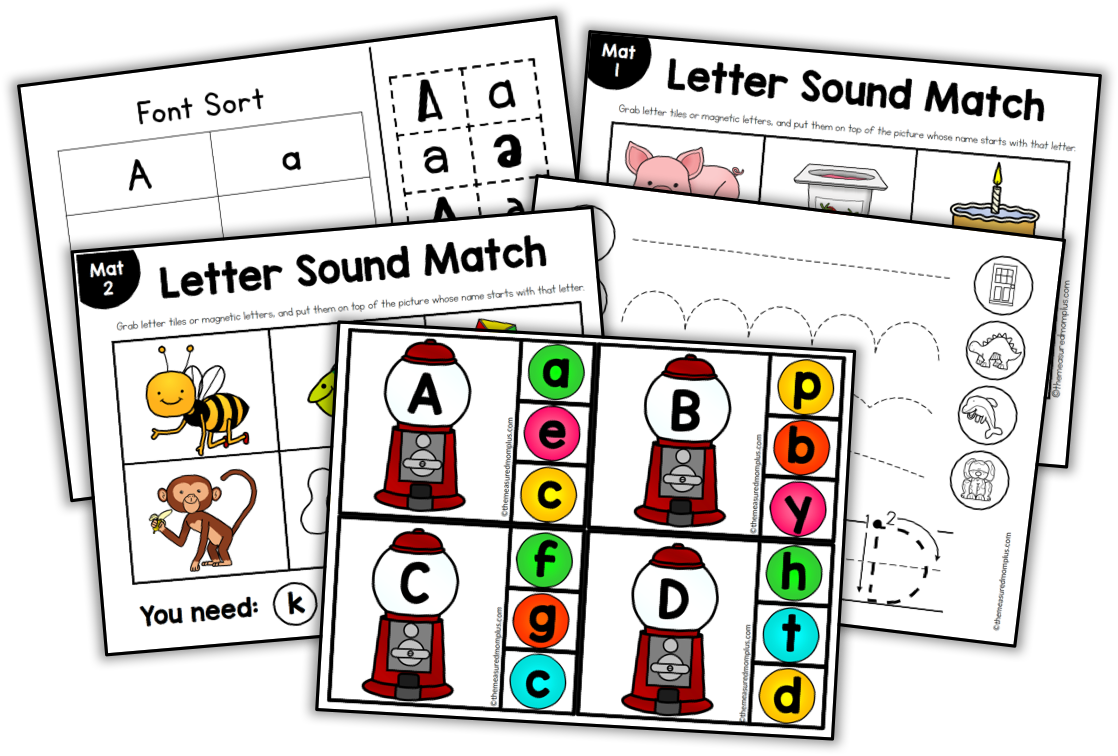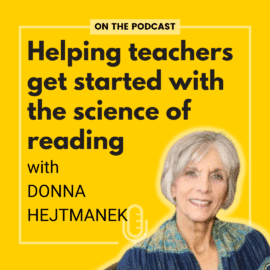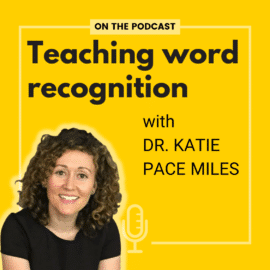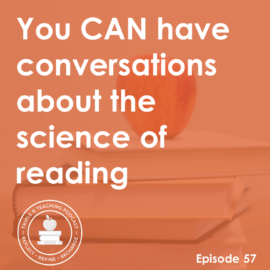TRT Podcast #117: What does research say about alphabet instruction? with Dr. Shayne Piasta
Teachers have a lot opinions about how to teach the alphabet – but what does the research really say? Find out in this conversation with Dr. Shayne Piasta!
Full episode transcript
Hello, this is Anna Geiger from The Measured Mom! I'm excited to let you know that my online course about teaching reading in K-2 is opening on Monday, May 8th. As we look forward to that, I'm going to be releasing a series of expert interviews here on the podcast.
We're starting today with Dr. Shayne Piasta. She's a professor of reading and literacy in early and middle childhood in the Department of Teaching and Learning at Ohio State University. She's also a researcher. Today, she's going to talk to us about what the research says and doesn't say about teaching the alphabet.
Anna Geiger: Welcome, Dr. Piasta!
Shayne Piasta: Hi, it's so nice to be here!
Anna Geiger: Can you introduce yourself to us? Tell us how you got into education and now what you're doing.
Shayne Piasta: Sure. So I began this journey, I think, even before I really was in higher education. My mom was a teacher, and so I was always really interested in what was going on in her classroom and what she was learning about at her professional development, and what she was doing. I spent a lot of time with her in her classroom.
I also saw a lot of new practices and new materials come down the road and her being asked to use those, and I always wondered, "Well, are these going to be helpful or not? Is there any data behind these practices to suggest that they might be helpful for children?"
And so when I went to my undergraduate institution, I was a psychology major but also took as many education courses as I possibly could, and I did a senior research project that was looking at teachers' knowledge about reading and what their reported practices were.
Then I moved into getting my PhD as an IES fellow at Florida State University in the Florida Center for Reading Research, where I really learned a lot about how we can and can't generate evidence to determine whether certain practices are effective. That's been really one of the trajectories of my career is really trying to generate evidence that education stakeholders, teachers, principals, and policymakers, can use to inform their decisions when they're making instructional decisions and decisions about curriculum and intervention and other aspects of practice. So that's really the crux of my research program, identifying and then validating these different types of practices to support young readers.
Anna Geiger: I think that's really interesting that, even as a young person, you were already thinking about data. That's so interesting because I always wanted to be a teacher, and I never once thought about that at all. I was just excited about getting in a classroom and doing all the fun things.
I think it's also good to hear from your perspective a little bit because before I really embraced the science of reading and structured literacy, I really thought of researchers as just being these far-out people that I could not connect with. I did not picture someone like yourself. I pictured people who were very separate from the classroom.
Can you talk to me a little bit about how you're connected to what's happening in classrooms these days?
Shayne Piasta: Much of my work, my research, takes place in classrooms. I'm not in a classroom as much as I was when I was hanging out in my mom's classroom, especially during nap time with the quiet music in the background - that was a really great destresser for me.
My research team is constantly out in schools, either providing intervention or instruction or collecting data with kids. We also try to stay in as much contact as we possibly can with both education policymakers as well as the teachers and principals and others who have bearing on instructional decisions.
So I may not be in the classroom, but I try to stay in touch with these stakeholders because ultimately, that's who I am serving along with the children.
Anna Geiger: Is there anything that you would say for alphabet instruction that we know for sure research backs it up?
Shayne Piasta: I think there are some things we know. For one, children show individual differences in their early alphabet, not only in their knowledge at its time point, but also individual differences in how their trajectory of learning about the alphabet is going, so how quickly they're picking up on this.
Those individual differences we also know can be linked with background factors as well as societal factors. Often the children who are starting off their school years with lower letter knowledge are tending to come from disadvantaged backgrounds. That would be one reason why it's so important to be attending to providing effective alphabet instruction.
Just as children vary, we also know that letters vary, and they can vary on a lot of different factors.
I gave the example of the acrophonic principle: some letters have their sound at the beginning of the name, some have it at the end of the name, some don't have it at all. The letters that children tend to be more familiar with, or at least the letter sounds children tend to be more familiar with, tend to be those letters like B in boy, where you're actually hearing the sound at the beginning.
In the US, children also tend to be more familiar with letters that are at the beginning of the alphabet than those at the end of the alphabet. They tend to be more familiar with letters that have a more visually distinct form. There are lots of other factors like this to the point where some folks, myself and others, have been able to rate the difficulty of particular letters, the likelihood that children would know a given letter, and you can see that it's really a continuum.
So that has implications, and now these implications have not necessarily been tested, but they have implications in terms of the instructional intensity that we want to devote to letters.
So a letter like W that tends to be one that's difficult for children for a variety of reasons, maybe we want to provide more intense instruction on that as opposed to the letter B, which children tend to often know even coming into kindergarten. So that's the second place where I think we have solid evidence.
The third place that I think we have converging evidence, or at least evidence that I'm convinced by, is that there is value in explicitly teaching letter names and letter sounds. There are numbers of studies that show engaging and explicit teaching of these leads to better learning than other types of instruction, implicit or explicit, that children might be receiving typically in their classroom. So it's certainly something that can be taught and can be taught explicitly.
Along with that, there's also a good deal of evidence suggesting that the most important component for kids learning names and sounds is the opportunity to see the letter and hear it paired with its name and sound. So again, that aligns with this idea of explicit instruction. It also aligns with this idea of paired associate learning.
So those are the top three, I would say. There are a couple other areas that we have converging evidence as well.
There's converging evidence from Roberts et al., as well as from my work, that teaching names and sounds simultaneously, so not necessarily doing one first and then the other, is most beneficial for young kids who are learning the alphabet. Those are rigorous experimental designs that are supporting that. I's this idea of converging evidence, but again, it's only a few studies.
Another area where, again, it's converging evidence, we don't have enough for it to be that rock-solid evidence that you're asking about, but I think we are on our way there is this idea that letters can be taught at a quicker pacing than what is typically done in many early childhood classrooms.
So a lot of classrooms do a letter of the week approach or something like that. One particular experimental study showed that teaching two to four letters per week led to better alphabet knowledge development than teaching only one to three.
Then there's a really interesting study that came out of Norway showing that teachers who introduced their students to letters more quickly, so they were getting through all the letters by the wintertime, their children did tend to have more positive alphabet knowledge and also reading outcomes later on. That's correlational, so we can't accept that as causal. But again, it's kind of converging with the other research suggesting that we could be teaching more than a letter a week to students, and that's actually beneficial for them.
Anna Geiger: Now would you say this is true in both preschool and kindergarten?
Shayne Piasta: Most of the studies have only been conducted in preschool or kindergarten.
Anna Geiger: Okay.
Shayne Piasta: I cannot think of a lot of different premises that have been tested in both grade levels, so what I would do there is think about would there be reason to expect that a slightly older or slightly younger child would react differently to a particular practice? I think in many cases we might say no. We'd expect a four-year-old and a five-year-old to benefit similarly from a particular practice if that practice is effective.
Anna Geiger: So you've already touched on things that we think we know, and things we do know. Is there anything that has not been studied that you think would be worth looking at?
Shayne Piasta: There's SO much that hasn't been studied. I think we know more than we actually know we know. I get questions a lot from teachers and other practitioners about this idea of letter sounds and letter names.
I get similar questions about uppercase versus lowercase. Is it better to teach children just the uppercase form and then move to lowercase, or to do those simultaneously? That's a study I would love to run.
There are lots and lots of questions about instructional sequence, and this is something too that I think a lot of scholars and teachers have a very strong view on, and they have a strong theoretical rationale for why they choose the instructional sequence that they do. But to my knowledge, this has not been tested, and it could be that the instructional sequences, some of them are equally effective. So that's an area that I think needs more attention.
Another area that needs to be studied is this idea of differentiation. We have evidence in other areas that differentiating instruction is important for maximizing children's learning. That hasn't really been directly studied here. So if we're asking practitioners to do something other than letter of the week, we need to know what it is that we might recommend based on evidence. And so one thing we might recommend is differentiating based on the letters kids know and the letters that they have yet to learn. And possibly, as I referred to earlier, differentiating based on the letter itself as well, so that the letter W is getting greater attention and supports than the letter B.
Anna Geiger: Sure.
Shayne Piasta: And so I think that's really important work that we need to be doing moving forward.
There's also a bit of controversy over teaching children to write the letters. There have been syntheses in which pairing alphabet instruction with letter writing or other writing opportunities seems to be associated with better outcomes. But there's also a direct test of this that Roberts et al. did, where they added a letter writing component to paired associate learning, and they did not see an added benefit of integrating the writing piece in there. I think, especially with the attention right now to reading and writing connections and things like that, it would be really important to continue following up on that research to understand whether or not we should be incorporating writing into our alphabet instruction.
Anna Geiger: Can you tell us about any current research that you're involved with or that you're hoping to do?
Shayne Piasta: I have lots of ideas. It's always a matter of finding the funding and the folks who want to do a project with me.
One thing that I'm continuing to work on is this idea of identifying best practices in alphabet instruction. We began this work a couple years ago, and the first thing that we wanted to do was to develop a set of lessons that were kind of modular in nature. So if we wanted to test it with uppercase letters versus lowercase letters or teaching them simultaneously, or if we wanted to test providing more intensity in a certain letter rather than another letter, we could use these lessons and tweak them so that the basic lesson was the same, but then you could make these tweaks to be able to test these differences in instructional practices.
So we finished up that work and we did a pilot study because we'd want to know do these lessons lead to improved learning before we start doing these little tweaks? We did indeed find that that was the case on both letter naming outcomes and letter sound outcomes and letter writing.
I am at the beginning stages now of taking that to the next step to answer some of these questions that we really, really want to answer, and I'm trying to figure out what the best way of doing that might be. I'm actually starting to put together a study where we could invite teachers from across the country to be partners in this work. We would recruit teachers who want to test a question, so we'll use the uppercase, lowercase as an easy example, who would want to then work with a student or two in their classroom following research protocols in order to contribute data to this larger project, so that we could then start answering some of these questions from the field. So that's one line that I've been working on in which I hope to continue.
The second thing that I am addressing in my work right now is the extent to which the timing of alphabet knowledge and development matters, the extent to which a trajectory matters. There's some prior work out of, I believe it was Finland, showing that children who had higher trajectories of alphabet knowledge tended to have better literacy outcomes as opposed to those who were kind of slow to acquire this knowledge.
So we followed up on that, that was specific to letter names. We followed up on that with a sample here in the US, where we both looked at letter names and letter sounds, and we found a similar pattern. We found that children could be characterized as one of three profiles.
There was a high profile, these were kids who already knew most of their names and sounds, and so there's actually very little room for growth, right? There's only 26 letters. So they were like this high, straight line if you would think about development in terms of how you would graphically represent it.
Then we had children who were growing in their alphabet knowledge, and so they were actually starting off much, much, much lower, but they had this really nice positive trajectory over time, where, at the end of our assessment points, they were very similar to the levels of knowledge of the kids in the high profile.
Then we had a delayed profile as well, where they started similar to the growing profile, so with lower levels of knowledge, but they were not making nearly as much progress. Why this is important is because these profiles continued to differentiate children on their kindergarten literacy assessments.
So even though the growing and high were now very similar, those students still had substantial differences in their kindergarten readiness scores, which was specific to literacy here in Ohio at the time. The kids in that delayed group, even though they started off the same as the growing, they had very different kindergarten literacy scores, and this makes me wonder about the extent to which the trajectory matters.
Some people say, why are we spending time researching or teaching alphabet knowledge when almost every kid masters this by first grade? Well, one, not every kid does master it by first grade. And two, it may be that the timing of when children are developing this knowledge, it may matter. When we think about things like consolidation coming from Ariès' theories and others, and this idea that they're putting together all this knowledge and all this learning, and they're using everything in order to propel their further literacy development and then that has often these reciprocal benefits for different skills.
So that's a study that we did, and we're now in the process of trying to replicate that in a different sample that includes children who are considered typically developing with respect to literacy, but also who have been identified as at risk for reading difficulties. For this sample, we actually have long-term outcomes, so we have followed them and have grade one reading and spelling outcomes.
We want to see, one, do we replicate these same patterns of development, and do these patterns actually matter when predicting kids' literacy skills? And if so, that should direct us as to whether yes, we need to be targeting this at a certain point in development, or no, all that matters is that you eventually understand the letter names and sounds and other aspects of alphabet knowledge.
Anna Geiger: You've given us a lot of really good information here about what we know, what we don't know, and what we're learning.
I believe, and I'll link to them in the show notes, that you have some free alphabet lessons posted. Is that correct?
Shayne Piasta: I do. Those are actually those lessons that we designed and pilot tested, so they do have evidence of being effective, and that's what we would be modifying to move further into identifying best practices for alphabet instruction.
We also have some free quick assessments that have been psychometrically tested as well, a short form for letter name knowledge and then also a short form for letter sounds. Those are also posted on the website and are free to use as well.
As we develop more materials, I'll continue posting to that website to try to get more information out to practitioners.
Anna Geiger: Wonderful. Well, in the show notes, I'll definitely link to all of that, and we'll just wrap up really quickly.
If you could tell us, what specific things did you have in mind about best practice when you created those lessons? What were you sure to include?
Shayne Piasta: So I will say most of that was an educated guess in terms of leaning on theory where we didn't yet have evidence, but some of the things we made sure to include were many, many opportunities for paired associate learning.
We included originally multisensory activities for children. That is a recommended practice, although actually, one of my former students did her dissertation on that and did not find an added benefit for the multisensory components. But I do think that they're helpful in terms of engagement and building rapport with kids as well.
We also made sure that we simultaneously taught both names and sounds for each of the letters. Then, based on the syntheses that had been done, we did include letter writing as a component in order for children to experience that, because at the time that we developed them, including writing with the lessons was, to the best of our knowledge, a best practice at the time.
Anna Geiger: Is there anything else you'd like to share before we end our conversation?
Shayne Piasta: Remembering that we may know less than we actually think we know and thinking about how we can constantly improve our instruction to better support kids. I really think keeping that in mind will help us as we're able to use research to inform what we do in classrooms.
Anna Geiger: Well thank you so much for all the research work you've done and continue to do. I know that many, many teachers are benefiting from that.
Thanks so much for listening today! You can find the show notes at themeasuredmom.com/episode117. Talk to you next time!
Sign up to receive email updates
Enter your name and email address below and I'll send you periodic updates about the podcast.
Links related to this episode
- Dr. Piasta’s articles
- Alphabet assessments
- Scroll down this page for free alphabet lessons developed by researchers








Leave a Comment